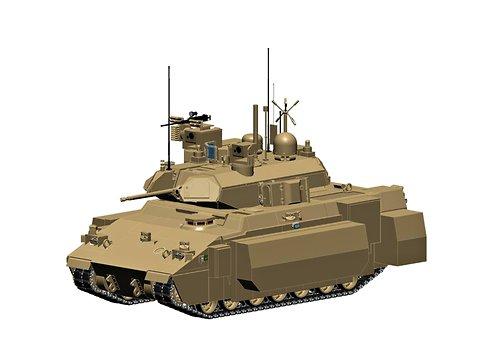 Is your Chevy Volt bulletproof? The green automotive technology usually associated with tree-hugging hippies is being used in a military application. The Ground Combat Vehicle, being developed by BAE Systems and Northrop Grumman, is a hybrid with tracks, armor, and guns.
Is your Chevy Volt bulletproof? The green automotive technology usually associated with tree-hugging hippies is being used in a military application. The Ground Combat Vehicle, being developed by BAE Systems and Northrop Grumman, is a hybrid with tracks, armor, and guns.
The Ground Combat Vehicle is built around a powertrain similar to the Volt’s. Two electric motors, good for roughly 700 horsepower each, drive the tracks, charged by a lithium-ion battery pack of unspecified size. Two diesel engines generate electricity for the batteries and electric motors but, just like in the Volt and other “extended-range electric vehicles,” they do not drive the wheels (tracks) directly.
Unlike the Volt, the Ground Combat Vehicle cannot be recharged by plugging-in. According to BAE, the vehicle will use its diesel engines to generate power all the time. There aren’t many three-pronged outlets on the battlefield, or many opportunities to stop for recharge.
Mark Signorelli, BAE’s vice president of combat vehicles, told the New York Times that one advantage of the hybrid powertrain is modularity; because the diesel engines are not connected to the tracks, they can be placed almost anywhere on the vehicle. The Ground Combat Vehicle will also have 50 percent fewer parts and will have 10 percent better fuel economy than similar vehicles, BAE said.
The vehicle itself, in concept rendering form, has large, protruding boxes hanging off its sides, which could house batteries or other parts of the hybrid powertrain. Either way, the added bulk should help protect the crew. While it does have a turret, the ambiguously-named Ground Combat Vehicle looks more like an armored personnel carrier or infantry fighting vehicle, like the M2 Bradley; the large hull could probably hold a few soldiers in addition to the crew.
The Ground Combat Vehicle will probably be the heaviest hybrid in existence; it is expected to weigh 140,000 pounds fully-equipped. Signorelli said the powertrain is up to the task of moving this behemoth, claiming that it has 30 percent more power than necessary, in case BAE wants to use it drive a heavier vehicle. He noted that electric motors produce a lot of low-end torque for quick getaways.
Signorelli told Defense Tech that the Ground Combat Vehicle’s development was one of the most painful he had ever gone through. Nonetheless, he is confident that hybrids will find their way onto the battlefield, saying that hybrid technology, once a radical idea, is used every day in cars and heavy construction equipment.
The Ground Combat Vehicle is currently under development, but The Department of Defense has not placed any orders yet. The price is expected to be $11 million per vehicle.


